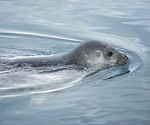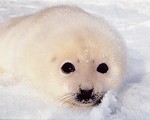| Origin & Development | |
|
Legends & Fairy tales • Earth's Crust Thickness • Underwater Relief • Landscapes • History & Formation • Seismic Activity • | |
| History of Lake Baikal | |
|
History of Explorations • Inhabitants & Settlers • First maps of Baikal • Archaeological Sites • | |
| Lake Baikal Climate | |
|
Introduction • Fogs • Winds & Waves • Ice Conditions • | |
| Fauna & Vegetation | |
|
Mammals • Baikal seal - Nerpa • Ichthyofauna • Invertebrates • Vegetation • | |
| Water of Lake Baikal | |
|
Colour • Transparency • Temperature • Pressure • Depth • Currents • Budget • Chemical Composition • Pollution • | |
| Recreational Areas | |
|
Circumbaikal Railway • Peschanaya Bays • Olkhon Island • Chivirkuysky Gulf • Wooden Irkutsk • Trans-Siberian Railway • | |
| People of Lake Baikal | |
|
People of Siberia • Buryat nation in Baikal • Russians in Baikal • | |
|
| |
Lake Baikal Seals - NERPA
Lake Baikal forms an ideal habitat for nerpa - plentiful food, mainly golomyanka fish and bullheads; an ice regime that creates the optimum conditions for nerpa's breeding and moult cycle, and rather large and deep water body. Since ancient times nerpa has been an important resource for man. It valued for its wonderful fur, median fat and soft meat. According to the archaeologists' data, since time immemorial nerpa has been attracting people to the Baikal shores. Once nerpa was used as an object of barter and was also regarded as a totem. Nerpa is a big animal, it grows about 120-150 cm long and can weigh as much as 100-120 kg; it has a long life span. Specimens that appear to at the age of 50 and even older have been found.
The seals usually spend the winter under ice. Each animal keeps open some air-holes. Often they are well hidden by snow-drifts or ice hummocks. Thus, it is an out of sight lair ("logovo"), where nerpa rests. Nerpa feeds mainly at night-time, as golomyanka fish, its favourite food, only concentrate after dark in the upper layer, 100 m deep, which is accessible for nerpa. At daytime the fish submerge to great depths. The average daily intake of a grown-up nerpa is about 3-4 kg of fish. So, throughout the year the nerpa eats up more than a ton of fish, mainly golomyanka. Man has often accused nerpa of aiding the extinction of omul. But the pursuit of omul requires considerable energy on the part of the seal. And nerpa prefers when available, the rather immobile golomyanka fish an bullheads. Nerpa is the only mammal endemic to Lake Baikal. At present the number of seals is estimated at around 60 000 heads (according to information gained by researchers E. Petrov and M. Ivanov, nerpa's population is no less than 100,000 animals.) | |||||||


